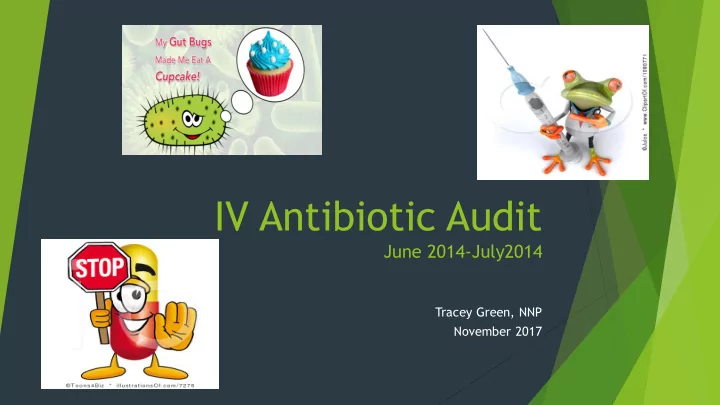

IV Antibiotic Audit June 2014-July2014 Tracey Green, NNP November 2017
Background “Suspected sepsis” One of the most common diagnoses made in the NICU Early-onset sepsis (EOS) a major cause of neonatal mortality and morbidity, particularly among preterm/very low-birth weight infants Low-incidence, high-consequence disease Clinical signs may be non-specific/absent in the immediate postnatal period.
Objectives To identify whether antibiotic use follows current antibiotic protocol To determine if antibiotic exposure has decreased following the implementation of the current antibiotic protocol Was maternal antibiotic cover appropriate according to current CWH guidelines Differentiate between well infants at risk of sepsis vs symptomatic babies with presumed sepsis
Policy: Early Onset Sepsis EOS defined: Infection within the first 72 hours following birth Treated with empiric antibiotics until sepsis is excluded Group B streptococcus (GBS) – most common cause alongside Escherichia coli. Maternal and infant clinical characteristics Infant laboratory values are utilised to determine newborns at risk
Risk Factors for EOS Prolonged rupture of membranes Maternal illness - eg. pyrexia >38.0, raised CRP Pathogens (e.g. GBS, E. coli) present in maternal urine or high vaginal swab Prematurity < 37 weeks Fetal distress, tachycardia >160bpm or neonatal depression T win gestation
Criteria for Commencing Antibiotics All newborn infants with early respiratory distress No infant should be untreated after 4 hrs of age Temperature instability Apnoea, especially new onset or increased frequency or severity in a premature infant Listlessness, lethargy, pallor, mottling and irritability Jaundice if it develops unusually rapidly Ileus (abdominal distension or bilious vomiting/nasogastric aspirate) Previously healthy baby who refuses to feed
Method A retrospective audit of clinical records for all infants admitted to the CWH NICU (established from the NICU database), requiring antibiotic treatment during the first 72hrs of life between June 2014 & July 2014.
Results Clinical records for 58 babies were reviewed 7 excluded leaving 51 babies 4 Surgical 1 Day 5 admission excluded 1 Day 10 Rhinovirus from paediatrics excluded 1 Transfer from Dunedin at 2wks of age Median birth weight was 2910g (Quartiles 2255-3840g).
Results <32wks 32-36wks >37wks Received 7 10 34 Antibiotics (51) Admitted No 1 16 13 Antibiotics (30) Maternal Abs in 5 6 15 labour Confirmed 2 0 4 Maternal Chorioamnionitis
Gestational Age of Babies Requiring Antibiotics: Mean Gestational 37wks 30 25 20 15 10 5 0 <32wks 32-36wks ≥37wks
≤48hrs Neonatal Antibiotic 23% Exposure 4% 60hrs 73% 5 days Duration of <32wks 32-36wks ≥37wks Antibiotics 24 hrs 5 5 8 36 hrs 4 5 48 hrs 2 6 2 + x2 5doses 3-5 days 2 10
Duration of Respiratory Support (Ventilation, CPAP , Oxygen) 16 14 12 10 8 6 4 2 0 ≤4hrs 5-12hrs 13-24hrs >24hrs All <32wk infants required respiratory support 80% <37wk infants 63 % ≥37wk infants Other Reasons: Tachypnoea, meconium exposure, thrombocytopenia, dehydration, CXR changes
Timing of CRP 40 35 30 25 20 15 10 5 0 <6hrs 6-12hrs 13-24hrs >24hrs 1st CRP 2nd CRP
1 st CRP Result 8% 8% ≤10 Oct-20 20-30 >30 84%
CRP Considerations An acute phase reactant synthesised within 6-8 hours in response to tissue injury Non-infectious processes can also elevate the CRP Levels peak at 24-48 hours A normal CRP at the start of an illness/at birth lacks the sensitivity to rule out sepsis If taken at >6hrs the sensitivity improves to >90% A level of <10mg/L is considered normal and has a negative predictive value of 99% for EOS
GBS Antigen Protocol A urine should be sent for GBS antigen 25% Done - indicates systemic GBS infection Not 75% Done If antibiotics are stopped after 24-48hrs and the baby is on the postnatal ward then it can be omitted
25 Delivery 20 Type 15 10 5 0 NVD Forceps Ventouse LSCS Elective LSCS Not Elective Non Elective LSCS Electives LSCS X2 Abruption X1 GDM on insulin X2 Breech X1 severe IUGR 32wks X1 set twins bulging membranes, X2 39wks x1 transverse, thinning scar X1 FTP X1 Post dates not in labour
Summary: Clinical Implications Early antibiotics for many are correct response Overall clinical picture important factor Reduced antibiotic exposure without compromising safety Appropriate and safe antibiotic treatment Decreased unnecessary intervention and antibiotic resistance. Joint responsibility for ensuring antibiotic review Decrease cost without increased risk to neonates. Reduce staff workload.
Future Recommendations Capture postnatal babies requiring antibiotics Reduce antibiotics exposure further Protocol review Determine Nationwide practices Stop antibiotics in timely manner Determine urine GBS antigen requirement Utilise evidence from this audit to further review current practice
International Data 36hrs minimum cover Use of Sepsis Calculators Limited research and supporting evidence determining appropriate IV antibiotic course duration NICE guidelines recommend treating neonates with risk factors but clinically well for 36hrs
Conclusion Clinical notes of 58 infants were reviewed of which 51 meet the required criteria Essentially antibiotics were given according to the new protocol Improvements can be made There is an ability to decrease antibiotic exposure while maintaining safety
Recommend
More recommend